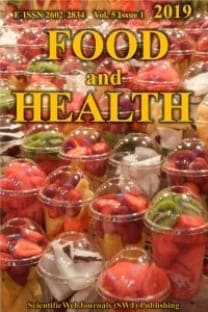Health effects of ethanolic extract from seeds of lady finger
Health benefits of lady finger were explored in this study by which the ethanol extract from the seeds was utilized for testing. In high glucose (350 mmole/L) medium, the proliferative activity of C2C12 cells was inferior, but their viability was improved following treated with the extract. The activities of antioxidant enzymes, superoxide dismutase (SOD) and catalase (CAT), were also enhanced. In response to such high glucose concentration, glucose uptake ability of these cells was compromised. The extract was demonstrated to increase the ability of glucose uptake by approximately equal to the effect of 200 nmole/L insulin. High intracellular reactive oxygen species (ROS) of RBM-MCS cells grown in high glucose containing medium was elicited. The level of ROS was reduced when the cells were cultured in contact with the extract. L929 cells were made inflammation and oxidative stress by incubating with 37.5 µmole/L DPPH for 30 min. The release of tumor necrosis factor-α (TNF-α) and interleukin 6 (IL-6) from these inflamed cells was inhibited by such treatment. Thus, lady finger might be advantageous in the protection of cells in the body that would be damaged or being susceptible to hyperglycemia and diabetes.
___
Alam, P., Parvez, M.K., Arbab, A.H., Siddiqui, N.A., AlDosary, M.S., Al-Rehaily, A.J., Ahmed, S., Kalam, M.A. Ahmad, M.S. (2017). Inter-species comparative antioxidant assay and HPTLC analysis of sakuranetin in the chloroform and ethanol extracts of aerial parts of Rhus retinorrhoea and Rhus tripartita. Pharmaceutical Biology, 55(1), 1450-1457. https://doi.org/10.1080/13880209.2017.1304428Azlim Almey, A., Ahmed Jalal Khan, C., Syed Zahir, I., Mustapha Suleiman, K., Aisyah, M. Kamarul Rahim, K. (2010). Total phenolic content and primary antioxidant activity of methanolic and ethanolic extracts of aromatic plants' leaves. International Food Research Journal, 17(4), 1077- 1084.
Bianco, P., Robey, P.G. Simmons, P.J. (2008). Mesenchymal stem cells: revisiting history, concepts, and assays. Cell stem Cell, 2(4), 313-319. https://doi.org/10.1016/j.stem.2008.03.002
Castro, A., Macedo-de la Concha, L. Pantoja-Meléndez, C. (2017). Low-grade inflammation and its relation to obesity and chronic degenerative diseases. Revista Médica del Hospital General de México, 80(2), 101-105. https://doi.org/10.1016/j.hgmx.2016.06.011
Dubois, V., Eeckhoute, J., Lefebvre, P. Staels, B. (2017). Distinct but complementary contributions of PPAR isotypes to energy homeostasis. The Journal of clinical investigation, 127(4), 1202-1214. https://doi.org/10.1172/JCI88894
Giustarini, D., Dalle-Donne, I., Tsikas, D. Rossi, R. (2009). Oxidative stress and human diseases: origin, link, measurement, mechanisms, and biomarkers. Critical Reviews in Clinical Laboratory Sciences, 46(5-6), 241-281. https://doi.org/10.3109/10408360903142326
Healthy diet. (2018, October 23). Retrieved from https://www.who.int/news-room/fact-sheets/detail/healthydiet (accessed 18.08.2019).
A healthy, balanced diet. (2016, October). Retrieved from https://www.nutrition.org.uk/healthyliving/healthydiet/healthybalanceddiet.html (accessed 18.08.2019).
Ighodaro, O. Akinloye, O. (2018). First line defence antioxidants-superoxide dismutase (SOD), catalase (CAT) and glutathione peroxidase (GPX): Their fundamental role in the entire antioxidant defence grid. Alexandria Journal of Medicine, 54(4), 287-293. https://doi.org/10.1016/j.ajme.2017.09.001
Kant, V., Gopal, A., Pathak, N.N., Kumar, P., Tandan, S.K. Kumar, D. (2014). Antioxidant and anti-inflammatory potential of curcumin accelerated the cutaneous wound healing in streptozotocin-induced diabetic rats. International Immunopharmacology, 20(2), 322-330. https://doi.org/10.1016/j.intimp.2014.03.009
Kim, Y. Park, C.W. (2019). Mechanisms of adiponectin action: Implication of adiponectin receptor agonism in diabetic Kidney disease. International Journal of Molecular Sciences, 20(7), 1782. https://doi.org/10.3390/ijms20071782
Lucassen, E.A. Cizza, G. (2012). The hypothalamic-pituitary-adrenal axis, obesity, and chronic stress exposure: sleep and the HPA axis in obesity. Current Obesity Reports, 1(4), 208-215. https://doi.org/10.1007/s13679-012-0028-5
Manee, S. Kaewsrichan, J. (2017). Cosmeceutical benefit of Abelmoschus esculentus L. seed extract. Journal of Pharmaceutical Research International, 19(6), 1-11. https://doi.org/10.9734/JPRI/2017/37587
Marcovecchio, M.L. (2017). Complications of acute and chronic hyperglycemia. US Endocrinology, 13, 1-17. https://doi.org/10.17925/USE.2017.13.01.17
Newsholme, P., Haber, E.P., Hirabara, S.M., Rebelato, E.L.O., Procopio, J., Morgan, D., Oliveira-Emilio, H.C., Carpinelli, A.R. Curi, R. (2007). Diabetes associated cell stress and dysfunction: role of mitochondrial and non-mitochondrial ROS production and activity. The Journal of Physiology, 583(1), 9-24. https://doi.org/10.1113/jphysiol.2007.135871
Rastogi, R.P., Singh, S.P., Häder, D.-P. Sinha, R.P. (2010). Detection of reactive oxygen species (ROS) by the oxidantsensing probe 2′,7′-dichlorodihydrofluorescein diacetate in the cyanobacterium Anabaena variabilis PCC 7937. Biochemical and Biophysical Research Communications, 397(3), 603-607. https://doi.org/10.1016/j.bbrc.2010.06.006
Rehakova, Z., Koleckar, V., Jahodar, L., Opletal, L., Macakova, K., Cahlikova, L., Jun, D. Kuca, K. (2014). Evaluation of the antioxidant activity of several naturally oc curring coumarins and their synthesized analogues by "ferric reducing antioxidant power" assay. Journal of Enzyme Inhibition and Medicinal Chemistry, 29(1), 49-54. https://doi.org/10.3109/14756366.2012.753589
Shannon, C., Merovci, A., Tripathy, D., Abdul-Ghani, M., Norton, L. Defronzo, R.A. (2018). Effects of hyperglycemia on skeletal muscle glucose metabolism in healthy subjects. Diabetes, 67(Supplement 1), 1920-P. https://doi.org/10.2337/db18-1920-P
Ware, M. (2019). Benefits and uses of okra. Retrieved from https://www.medicalnewstoday.com/articles/311977.php (accessed 15.11.2019)
Wongwitwichot, P., Kaewsrichan, J. (2017). Induction of rat marrow stromal cells by FGF2 and insulin activates transcription of runx2 gene through ap1 consensus sequence. Journal of Advances in Medicine and Medical Research, 24(7), 1-15. https://doi.org/10.9734/JAMMR/2017/37534
Woodfield, J. (2016, March 03). Study uncovers extent of muscle weakness in people with type 2 diabetes. Retrieved from https://www.diabetes.co.uk/news/2016/mar/study-uncovers-extent-of-muscle-weakness-in-people-with-type-2- diabetes-92465800.html (accessed 18.08.2019).
- ISSN: 2602-2834
- Yayın Aralığı: Yılda 4 Sayı
- Başlangıç: 2018
- Yayıncı: ScientificWebJournals (SWJ) Özkan Özden
Sayıdaki Diğer Makaleler
Sokak gıdalarının güvenliği için risk faktörlerinin değerlendirilmesi
Food safety knowledge of food handlers working in hotel kitchens in Turkey
Health effects of ethanolic extract from seeds of lady finger
Jasadee KAEWSRICHAN, Paweena WONGWITWICHOT, Sirikhwan MANEE
Probiyotikli devam formülünde probiyotiğin canlılık çalışması
Murat DOĞAN, İSMAİL HAKKI TEKİNER
Gabriela Silvina RAZZETO, Jos El as Rojas MORENO, Elba Graciela AGUILAR, Edmundo Guillermo PEIRETTI, Viviana Romina Lucero LOPEZ, Graciela de Jes s ALBARRACIN, Nora Lilian ESCUDERO
